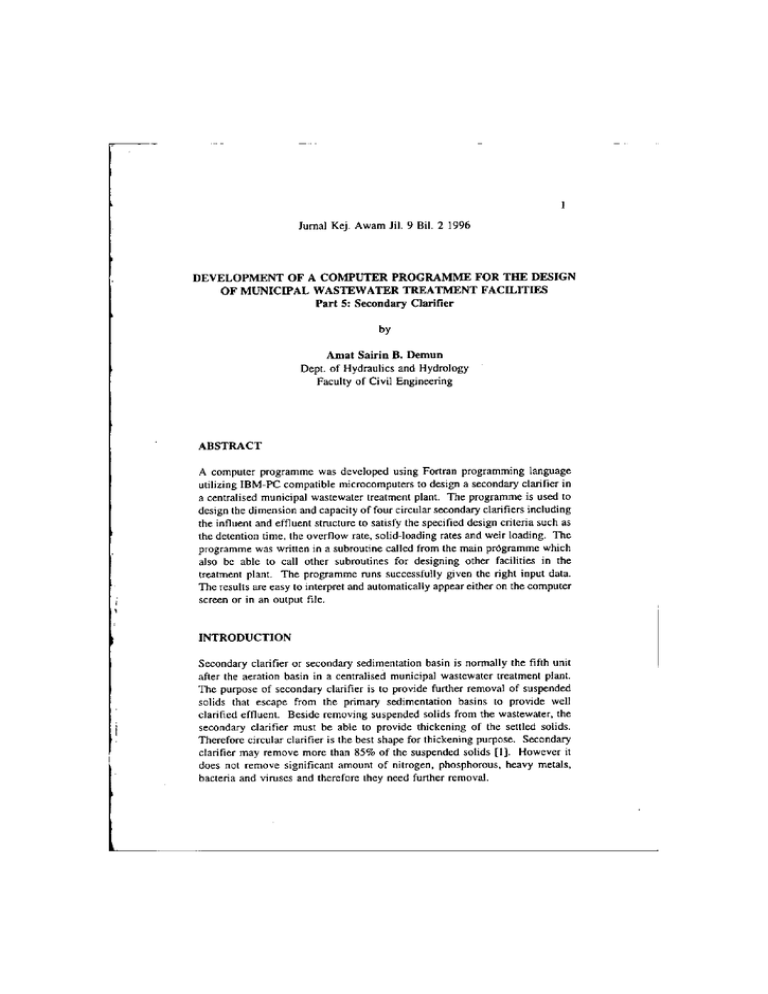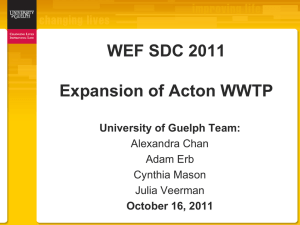lurnal Kej. Awam IiI. 9 Bil. 2 1996
advertisement

lurnal Kej. Awam IiI. 9 Bil. 2 1996 DEVELOPMENT OF A COMPUTER PROGRAMME FOR THE DESIGN OF MUNICIPAL WASTEWATER TREATMENT FACILITIES Part 5: Secondary Clarifier by Amat Sairin B. Demun Dept. of Hydraulics and Hydrology Faculty of Civil Engineering ABSTRACT A computer programme was developed using Fortran programming language utilizing IBM-PC compatible microcomputers to design a secondary clarifier in a centralised municipal wastewater treatment plant. The programme is used to design the dimension and capacity of four circular secondary clarifiers including the influent and effluent structure to satisfy the specified design criteria such as the detention time, the overflow rate, solid-loading rates and weir loading. The programme was written in a subroutine called from the main programme which also be able to call other subroutines for designing other facilities in the treatment plant. The programme runs successfully given the right input data. The results are easy to interpret and automatically appear either on the computer screen or in an output file. INTRODUCTION Secondary clarifier or secondary sedimentation basin is nonnally the fifth unit after the aeration basin in a centralised municipal wastewater treatment plant. The purpose of secondary clarifier is to provide further removal of suspended solids that escape from the primary sedimentation basins to provide well clarified effluent. Beside removing suspended solids from the wastewater, the secondary clarifier must be able to provide thickening of the settled solids. Therefore circular clarifier is the best shape for thickening purpose. Secondary clarifier may remove more than 85% of the suspended solids [1]. However it does not remove significant amount of nitrogen, phosphorous. heavy metals, bacteria and viruses and therefore they need further removal. 2 THE DESIGN CRITERIA The computer programme was written to design four circular secondary clarifiers in which each clarifier can operate independently with respect to the aeration basin upstream, One clarifier can be taken out of service for maintenance. The clarifiers are designed to handle average design flow plus the return flow. To achieve the function of the secondary clarifiers, they must be designed to provide sufficient detention period which is not less than 1.5 hour at peak design flow plus recirculation. The clarifier depth must be sufficient for solids not to flow with the effluent and also to provide storage for the settled solids for thickening purpose. Qasim [I] suggested that the overflow rale at average design flow and at peak design flow should not exceed 15 and 40 m3/m2.day respectively while the solid loading rates at average and peak design flow condition should not exceed 50 and'iSO kglm2.day respectively. The weir loading at the effluent weir should not exceed 124 mJ/m.day at average design flow. THE DESIGN OF CLARIFIER The flow pattern in a circular clarifier is radia1. Therefore the influent must be a central feed type. The design flow, Q in mJ/s flowing into the four clarifier is the average design flow plus the return sludge flow and minus the mixed liquor suspended solid (MLSS) wasted. The average'design flow is calculated in the main computer programme which is based on the number of population served for the treatment plant. The return sludge flow, Q, and the MLSS wasted are calculated in SUBROUTINE AERAT which is a subroutine to design aeration basin. SUBROUTINE AERAT was discussed previously in Part 4. The surface area of each of the circular clarifier is computed using equation:- A where Q, x s 3600Q,X s (I) the design flow to each clarifier (mJ/s) Q/4 (there are four circular clarifiers) MLSS concentration 3.75 kglm' [Qasim, 1985] limiting solid flux value 2.0 kg/m'.hour [Qasim, 1985) From the value of surface area, the diameter of each circular clarifier can be determined. The actual overflow rate. V in mJ/m2.day at average design flow 3 (and when all four clarifiers operate) and at critical flow condition (at peak flow and when only three clarifiers operate) is computed using equation:- v = UQi (2) n where unit conversion (86400 second/day) average or peak flow plus return sludge flow (m)/s) number of clarifiers operating (3 or 4) u Q, n This actual overflow rate must satisfy the design criteria which is not less than 15 m3/m2.day for average flow and 40 m3/m1.day for critical or emergency flow condition. If the calculated value of the actual overflow rate does not satisfy the design criteria, the computer programme is designed to request the user to input the new increased value of the clarifier's diameter in meter. This request value will be repeated until the final diameter satisfy the overflow rates with respect to the specified design criteria. 2 Based on the final diameter of each clarifier, the solid loading. Ls in kglm ,day can be computed using cquation:- L, where A, (3) the surface area of the circular clarifier (m2) which is computed based on the final clarifier's diameter. The actual value of solid loading must also satisfy the specified design criteria and if it docs not satisfy the design criteria, the computer programme will again request the user to input the new increased clarifier's diameter. The side depth of the clarifier is determined using a basic formulation which is equal to the depth of clear water zone plus the depth of thickening zone and the depth of sludge storage zone and plus a 0.5 meter freeboard for safety. The clear water and settling zone is taken generally to be 2.0 meter while the depth of thickening zone is equal to:- 4 (4) I, where x, concentration of the thickened sludge. 7.0 kg/m' [Qasim, 1985] total solids in the clarifier (kg) 30% of ms total mass of solids in each aeration basin which is equal to;- s, I', m, ms = XyLw where y (5) water depth in the aeration basin (meter) length of the aeration basin (meter) width of the aeration basin (meter) L The dimensions (y, Land w) of the aeration basin was computed previously in SUBROUTINE AERA T. The sludge storage zone is computed using equation:- (6) I, where s, solids stored in each clarifier (kg). The detention time of the wastewater in the clarifier is calculated based on the volume of the clarifier and the design flow rate. The computer programme calculates the detention time under average design flow plus recirculation, under peak design flow plus recirculation and under emergency condition (peak flow plus recirculation when only three clarifiers operate) and they must satisfy the specified design criteria. Figure 1 shows the detail of •.he secondary clarifier. 5 INFLUENT AND EFFLUENT STRUCTURE The influent structure is located at the centre of each clarifier. The structure is called the central feed well influent structure. An influent pipe will be installed across the clarifier (at the bottom side) which discharges the wastewater from the aeration basin into the clarifier through the influent-riser pipe and the central feed well. The central feed well will distribute the wastewater evenly and under quiescent condition throughout the clarifier. The diameter of the centre feed well is typically between 15 to 20 percent of the total diameter of the clarifier which range from 1 to 2.5 meters [2]. The effluent structure consists of several components which include effluent baffle, effluent launder. effluent box, 90° V-notch weirs and a pressure outlet pipe. The width of the effluent launder is designed to be 0.5 meter which is located around the circumference of each circular clarifier. The weir plate length can be calculated based on the diameter of the clarifier and the width of the effluent launder. The 90 V-nOlch is 8 em deep at 39.5 cm centre-to-centre. From the dimension of the V-notch and the length of the weir plate, the total number of V-notches can be computed. The head over the V-notch is computed using equation:0 15 H ~ [ If where Cd Q Q cJff: 'on45' J" (7) 0.60 (weir coefficient) flow through each V-notch at average design flow and at peak design flow when only three clarifiers operate (m'!,). If the head over weir. H at both design flow conditions is greater than the notch depth (8 ern), the notch depth should be increased. The actual weir loading at average design flow and at emergency flow condition can be computed which is equal to the design flow divided by the length of the weir plate. The weir loading at average flow must satisfy the design criteria which is not more than 124 mJ/m.day. The computer programme also calculates the depth of the effluent launder which is based on the characteristics of the effluent box and the hydraulic profile in the clarifier, in the effluent launder and in the effluent box. Clarifiers with diameter between 3.6 to 9.0 meter is equipped with sludge removal facility supported on beams across the clarifier while clarifiers with 6 diameter of 10.5 or larger must have a central pier that supports sludge scraper blade [2]. The clarifier is built with a walkway travelling bridge equipped with handrailing. The detail of the effluent structure with the hydraulic profile is shown in Figure 2. THEPROGRA~ESTRUCTURE The computer programme was written using Fortran programming language utilizing IBM-PC compatible microcomputers. The structure of the programme for the design of secondary clarifier is outlined in a flowchart shown in Figure 3. The programme was written in a subroutine named SUBROUTINE SECOND. The subroutine is called from the main programme which also be able to call other subroutines to design other units in a municipal wastewater treatment plant. SUBROUTINE SECOND must be run after SUBROUTINE AERAT is run, This is because some output data from SUBROUTINE AERAT is needed 10 run SUBROUTINE SECOND. RUN EXAMPLE AND RESULTS The computer programme runs easily after the DOS command A:>WWTREAT which stands for WasteWater TREATment. Input data file is not needed to run the programme. Some of the input data are obtained after running the main programme and some are obtained after running SUBROUTINE AERA T. The input data obtained from the main programme is only the peak design flow rate while the data obtained from SUBROUTINE AERAT are the return sludge flow, the MLSS wasted, the average and peak flow plus the recirculation, the BOD5 flowing out from the aeration basin and the dimensions of the aeration basin. Appendix 1 shows the run example for the secondary clarifier for a local municipal wastewater treatment plant which serves a total population of 170.45 thousand people. CONCLUSION The calculations for the design of the secondary clarifier actually use a simple method and technique provided a clear design criteria. However the process of calculations might consume much time if it is done manually. Trial and error procedure is involved in the design of the clarifier to satisfy the given design criteria. Therefore for convenience and best results. such calculation can be easily performed using a computer programme. This particular computer programme has a capability to design a secondary clarifier. It is guaranteed to be accurate and faster compared to manual calculation. It is more versatile and easier to use. The results are easy to interpret and automatically appear either 7 on the computer screen or in an output file and it is ready to be included in any design report of a centralised municipal wastewater treatment plant. REFERENCES r I [1] Qasirn, R.S (1985). Wastewater Treatment Plant - Planning, Design and Operation. CBS Publishing, Tokyo, Japan. (2J Tchohanohlous. G. and Burton, F.L. of Metcalf & Eddy. Inc (1991). Wastewater Engineering - Treatment, Disposal, and Reuse. Third Edition. McGraw-Hili Inc, Singapore. 8 (~PIBnWsw _______ ~f..lI!"" I (b) Elsva/jon Wsw j J FIGURE 1: Secondaty Clarifier ~ 9 Em"tmt lMIfM 0.5m I~ I EIfhMnt uuntitN OUtl8tPf~ 0.8 m tilvnemf (B) DstBil of EffI/1Bnt StnJeturs end Hydraulic !'rolilfJ HNtiO~WlW' .1 ptMk How .mi I. :}9.5cm :1 opt1flJtrI Tor.! Wltlf PI.,." LtmgtIl • Lwp (b) OBtBllof Weir Plste end V.notchBS FIGURE 2: Detail of Effluent Structure (Length Symbols = See Progremme Output File) ,I 10 _. "" DsIJP'l m-.t StNctur. • V-not'l:hMdrIpth. ~ ._.-r~1MI/fI! FIGURE 3: flowchart tor the Design of Secondary Clarifier (Subroutine SECOND) 11 APPENDIX 1 OUTPUT w W W w w W W W W W W WW WW W W *»»» * * TTTTT W W W WW WW WW W W T T T T FILE RRRR R R RRRR R R R R EEEEE programmed ,.. AMAT Universiti SAIRIN TTTTT A AA A A AAAAA A A * * * by DEMUN Teknologi T T T T «««* DESIGN OF MUNICIPAL WASTEWATER TREATMENT PLANT FACILITIES ,.. * EEEEE E EEE E ,.. Malaysia ,.. *************************************************** Project Name Wastewater Program run by Organization Date Output Filename Amat Sairin Demun Universiti Teknologi 21 st March 1997 DESIGN Treatment for the City of XYZ Malaysia A: OUTPUT. OUT INFORMATION 170.450 thousand 1.185 rn3/s l. 2 _ 3 _ 4 _ Number of population Served, P Peak Design Wastewater Flow, Qpk Average Design Wastewater Flow, Qav Minimum Design Wastewater Flow, Qmn 5.0 ************************************************* SECONDARY CLARIFIER / SOLID SEPARATION FACILITY ************************************************* Purpose: To provide 5.1 DESIGN further removal of suspended .444 rn3/s .200 m3/s solids. CRITERIA 1. Provide four circular clarifiers, each have independent operation with respect to the aeration basins. 2. The clarifiers are designed for average flow plus the recirculation. 3. Check the hydraulic performances of the influent and one the effluent structures at peak design flow when clarifier is out of service. 12 Appendix 1 continued 4. The return sludge from each clarifier must have an independent sludge withdrawal arrangement with flow flow measurement devices. 5. The overflow rate at average flow < 15 m3/m2.day and at peak flow < 40 m3/m2.day. 6 ..The solids~loading rates at average flow < 50 kg/m2.day and at peak flow < 150 kg/m2.day. 7. Scum baffles and scum collection 8. Weir loading 5.2 DIMENSION < 124 m3/m2.day system must be provided. at average design flow OF THE CLARIFIER ,. Design 2. 3. 4. 5. 6. 7. B. 9. 10. ". flow to the clarifiers .780 m3/s Design flow to each clarifier (4 nos) .195 m3/s Diameter of each clarifier, D 40.9 m Overflow rate @ average flow 12.8 m3/m2.d Overflow rate @ peak flow & 4 operate 24.3 m3/m2.d Overflow rate @ peak flow & 3 operate 32.4 m3/m2.d Depth of the clarifier, Dp 3.9 m The overflow rates satisfy the design criteria ==> OK Detention time @ average flow 6.4 hr Detention time @ peak flow & 4 operate 3.4 hr Detention time @ peak flow & 3 operate 2.5 hr 5.3 INFLUENT STRUCTURE The influent structure consists influent pipe must be installed will discharge into the central should pass under the baffle and throughout the clarifier. 5.4 EFFLUENT of a central feed well. An across the clarifier that feed well. The influent then distribute uniformly STRUCTURE 1. The effluent structure consists of:o effluent baffle o V notches o effluent launder a effluent box o a pressure outlet pipe 2. Provide 90 deg V notches on the weir plate on one side of the effluent launder 3. Provide width of the effluent launder 0.5 m 4. Provide 8 cm deep notches at 39.5 cm centre to centre. 5. Length of effluent weir plate, Lwp 125.4 m 6. Total number of notches 317 7. Head over notch @ average flow, HI 3.8 cm 8. Head over notch @ peak flow & 3 operate,H2 = 6.1 cm 9. HI and H2 is less than notch depth (8 cm) ==> OK 13 Appendix 1 continued 10. Weir Weir loading loading 11. Weir loading @ average flow 83.3 rn3/m2.d < 124 m3/m2.d (design criteria) ==> OK @ peak flow & 3 operate 272.2 m3/m2.d 12. Effluent Launder:o Provide effluent o Provide at least D box of 2 m x 2 m 0.8 m diameter outlet pressure The pipe is an inverted syphon connected pipe. to a common junction box. o The water level in junction box is kept such that the depth of flow in the effluent box at peak flow is kept at 0.61 m. o Provide invert of the effluent launder 0.3 m above the invert of the effluent box. o Depth o Water END OF OUTPUT of effluent launder @ ave flow, Depth in Effluent Launder, yl FILE Del .77 m .45 m






